The 2013 MacBook Air Review (13-inch)
by Anand Lal Shimpi on June 24, 2013 12:01 AM ESTThe GPU: Intel HD 5000 (Haswell GT3)
Hire enough ex-ATIers and you’ll end up really caring about GPU performance apparently. It’s good to see that Apple still views increasing GPU performance as non-negotiable, even at the MacBook Air level. Discrete GPUs are out of the question in the MacBook Air, so all models ship with Intel’s on-die processor graphics. More importantly, all CPU choices integrate the largest GPU offering: Intel’s HD 5000 (aka GT3).
Clock speeds alone prevent the 40 EU GPU implementation from being called an Iris 5100. Given the 15W TDP limit, Intel wouldn’t be able to do the Iris name justice even if it tried.
It’s hilarious that Intel refused to give out die photos for anything other than quad-core Haswell GT2, citing competitive concerns, yet at Apple’s WWDC launch of the new MacBook Airs we got to see the first die shot of a dual-core Haswell GT3. Update: I stand corrected. Intel posted its own shot here.
From the die photo it’s very obvious that like the quad-core Haswells with Iris Pro, the dual-core GT3 parts are over half GPU. Here's the only Haswell die shot Intel PR officially released by comparison, a quad-core GT2 part that's mostly made up of CPU cores:
Similar to the CPU discussion, on the GPU front Haswell has to operate under more serious thermal limits than with Ivy Bridge. Previously the GPU could take the lion’s share of a 17W TDP with 16 EUs, now it has 15W to share with the PCH as well as the CPU and 2.5x the number of EUs to boot. As both chips are built on the same 22nm (P1270) process, power either has to go up or clocks have to come down. Intel rationally chose the latter. What you get from all of this is a much larger GPU, that can deliver similar performance at much lower frequencies. Lower frequencies require lower voltage, which in turn has a dramatic impact on power consumption.
Take the power savings you get from all of this machine width, frequency and voltage tuning and you can actually end up with a GPU that uses less power than before, while still delivering incrementally higher performance. It’s a pretty neat idea. Lower cost GPUs tend to be smaller, but here Intel is trading off die area for power - building a larger GPU so it can be lower power, instead of just being higher performance.
| A Historical Look at MacBook Air GPU Performance | |||||||||
| 2011 | 2012 | 2013 | |||||||
| GPU | Intel HD 3000 | Intel HD 4000 | Intel HD 5000 | ||||||
| Manufacturing Process | 32nm | 22nm | 22nm | ||||||
| Frequency | 350/1150MHz | 350/1050MHz | 200/1000MHz | ||||||
| Cores | 12 | 16 | 40 | ||||||
| Peak GFLOPS | 165.6 GFLOPS | 268.8 GFLOPS | 640 GFLOPS | ||||||
| TDP | 17W | 17W | 15W | ||||||
This is an even bigger deal because few of the other OEMs seem interested in paying for the larger die. Acer’s S7 uses Intel’s HD 4400 (Haswell GT2, 20 EUs), as do most of the other Haswell Ultrabooks that have been announced thus far. Armed with a 2011, 2012 and 2013 MacBook Air as well as Acer’s 2nd generation S7, we now have the ability to compare everything from Intel’s HD 3000 (Sandy Bridge) all the way up to HD 5000. It’s important to keep in mind that with the exception of HD 3000, everything here is built on the same 22nm process, and with HD 4400/5000 TDPs actually went down. In other words, post Ivy Bridge, any GPU performance gains were very hard to come by.
I’m splitting up the GPU performance data into three sections. The first is a look at some games/settings that are actually playable on processor graphics. The second is comparison data for laptop Bench. The deltas here are academic at best since nothing slower than Iris Pro can really deliver playable frame rates in our high-end notebook GPU tests. The final section focuses on synthetic performance, which should help characterize the peak theoretical gains you can expect from HD 5000.
All of the gaming tests were run under Boot Camp/Windows 8. I think it’s time to retire the HL2/Portal testing under OS X.
Playable Gaming Performance
There's a surprising number of games that are actually playable on Intel's HD 5000 in the MacBook Air. You have to be ok with the fan spinning quite loudly, but it's possible to get some ultra portable gaming in if you're up for it.
For all of these tests I stuck with 1366 x 768 so I could run comparable data on the only HD 3000 equipped MBA I had, an 11-inch model. I also threw in data from Inte's HD 4400 using the new Haswell equipped Acer S7. I'll start with GRID 2, a brand new racer, running at relatively low quality settings.
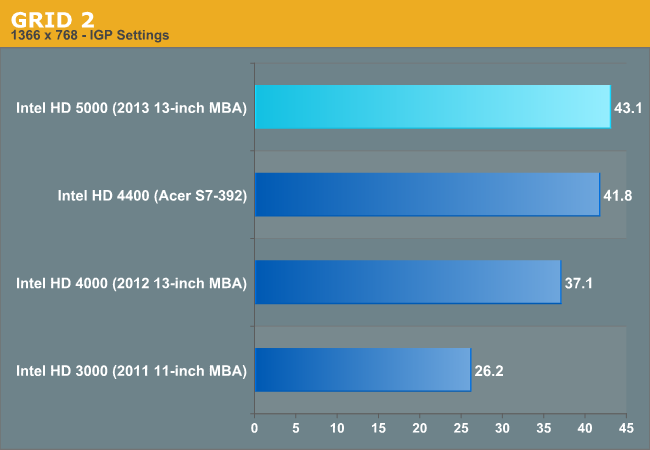
GRID 2 is absolutely playable on the new MacBook Air. At 43.1 fps it's 16% faster than last year's HD 4000 model. A 16% gain without increasing TDP on the same manufacturing process is pretty impressive. The gains over the 2011 MBA are substantial. GRID 2 goes from almost playable to fast enough where you can actually turn up some of the quality settings if you wanted to.
Next up is Borderlands 2. Again, a fairly modern title, but one that's really optimized for current generation consoles - making high-end processor graphics more than up for the task. While a higher TDP implementation of Haswell's integrated graphics wouldn't have an issue here, things are a little more difficult with a 15W TDP.
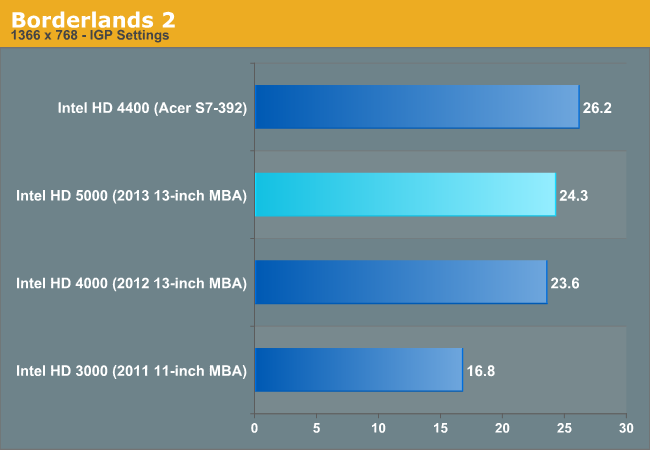
We see a marginal improvement over the HD 4000, we're clearly thermally bound at this point. What's interesting is the HD 4400 on the S7 is actually quicker here. The difference could be cooling or how Apple decides to scale back on GPU frequency when faced with thermal limits. A quick look at Haswell's power reporting confirms that while running my Borderlands 2 test the GPU was already exceeding the PL1 (Power Limit 1) of 15W:

Remember, with Sandy Bridge Intel introduced Turbo Boost 2.0 that effectively allowed for two separate power limits - one equal to the processor's TDP (PL1) and one higher than the processor's TDP (PL2) that could be hit as long as the die temperature doesn't get too high.
Despite the sub 30fps frame rate in this benchmark, Borderlands 2 was definitely playable on the HD 5000. It wasn't always smooth but if you need your single player fix, it'll suffice.
I've had a few requests to bring back our Minecraft benchmark. We ditched it from our higher end GPU reviews since it's no longer stressful enough, but for 15W TDP iGPUs it's perfect.
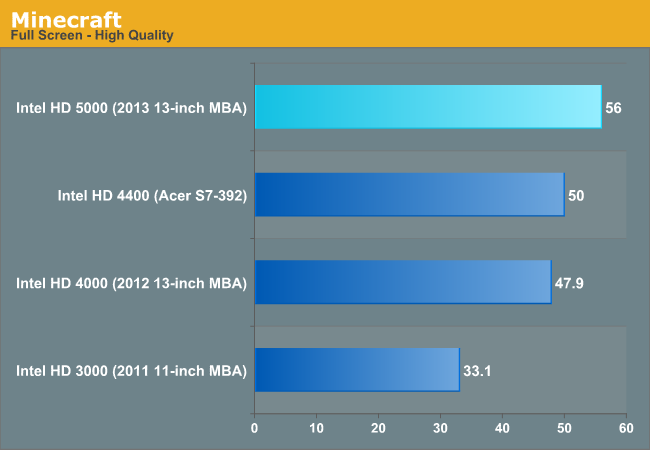
Once again we see almost a 17% increase over Intel's HD 4000. The HD 4400 comparison is also very impressive with a 12% increase in performance vs. what most MBA competitors will be using.
When I was a kid all I wanted was a console that could play arcade quality ports of Street Fighter II and Mortal Kombat II. These days, even the latest Street Fighter title has no issue playing on free graphics:
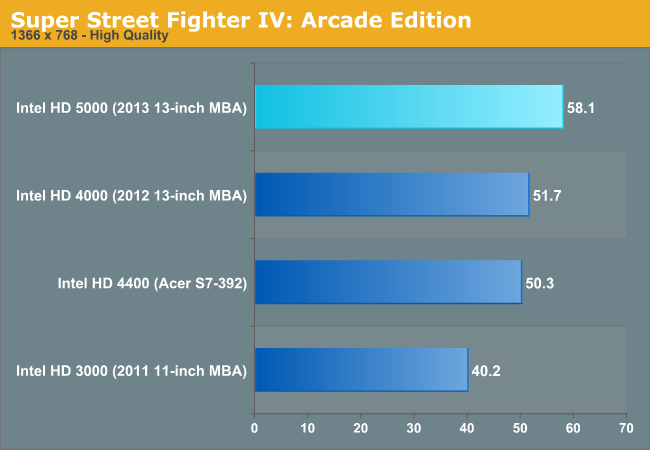
16% seems to be the magic number as that's exactly how much faster HD 5000 is compared to HD 4000. Given the lower TDP this year, that's a pretty reasonable gain. Looking at the sheer number of transistors that had to be used to get there however gives you good insight into just how hard it is to improve performance without a corresponding process node shrink.



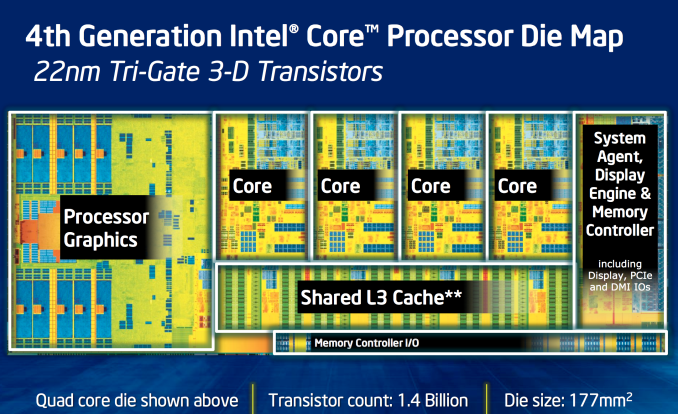
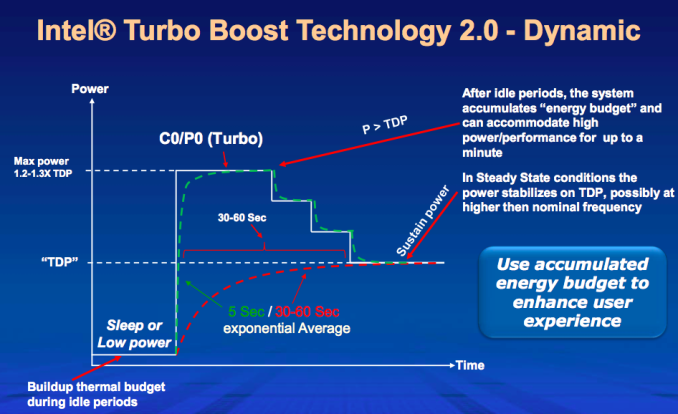








233 Comments
View All Comments
lilo777 - Monday, June 24, 2013 - link
It would help if you disproved something that was so wrong in my post. Perhaps people using OSX in their names are simply incapable of recognizing any Apple bias?akdj - Thursday, June 27, 2013 - link
In the ultra book market... and this price point....there aren't a lot of excellent choices right now for displays. If you step up to $1500-$1800...yes, one or two of the UltraBook vendors are selling 1080p IPS panels. At this price though...in the 'true' UltraBook sense of the word....go shopping at Best Buy sometime. Take a look at what Dell, Toshiba, Samsung and others are offering....again @ $1099. Asus is honestly the only one, in my opinion...that you can buy odd the shelf that competes. Period. You're right...it's time we get a 'better' panel. Perhaps 2014 will bring IGZO technology and production up to speed...IPS prices drop a bit...and Apple decides to equip a higher quality display. I'm all for it. But the current displays don't suck. They're excellent for what they are and at the current 'price point' you can't get that killer high rez panel from Sony. As well...at this size 11"), unless you double the resolution and pixel double as in the rMBP...raising the default resolution too much and text, icons, etc become to small. I'm always amazed at how much real estate I actually DO have on my 11" Air (2011)....in apps with 'full screen' capability....and until I bought the rMBP 15" last summer...I only used 17" MBPs!TheinsanegamerN - Sunday, June 30, 2013 - link
everyone overlooks something else with the 13 inch air's display...it's 16:10. which is amazing. i'd gladly take this over 16:9 anyday. wish more oems would go back to 16:10. and having seen the screen, and with a bias against macs...i kinda want one of the new airs.darwinosx - Monday, June 24, 2013 - link
The display is not glossy. Read the article you are commenting on.lilo777 - Monday, June 24, 2013 - link
You do not need to read the article to know that all Apple displays are glossy. It seems you do not even know what matte display looks like.Sm0kes - Monday, June 24, 2013 - link
Apple's Macbook Air lineup, while not as "glossy" in appearance as the Retina Macbook Pro's do still have a glossy coating. As a long time hater of glossy displays on notebooks, I have no issue with my Air.amrs - Tuesday, July 23, 2013 - link
No WWAN either. I think I'll upgrade my Thinkpad X201 to an X240s when those come out if it's any good. With matte display and 3G/4G inside too. Just the basics for mobile usage really.Strulf - Monday, June 24, 2013 - link
1920 x 1200 certainly would be nice. I want to upgrade my 2009 MBA but I'm gonna watch for the next revision - hopefully with a higher resolution then.thinkpanda - Monday, June 24, 2013 - link
I would like to share a few experience regarding to WiFi performance.I am using late 2011 MBP 13", which should support 3x3 802.11n. I connect home devices with Asus RT-AC66U router. I have a home server of Ubuntu Server 12.04 LTS, with Realtek 8168 GB Ethernet chip connected to the router. The home server has netatalk service installed to support AFP so that I mount the home server storage from MBP using AFP.
When I copy file from server to my local SSD (just by dragging the file at Finder), I get file transfer rate of 39MB/s! This is not even an AC network, just N network.
So I am curious that is it the server size TCP windows size settings affect the performance, and the OS X as client device is not affect at all ?
mikk - Monday, June 24, 2013 - link
"It’s hilarious that Intel refused to give out die photos for anything other than quad-core Haswell GT2, citing competitive concerns, yet at Apple’s WWDC launch of the new MacBook Airs we got to see the first die shot of a dual-core Haswell GT3"Anand you are plain wrong here. Bad job! ULT GT3 photos are available from Intel since weeks!!!
http://download.intel.com/newsroom/kits//core/4thg...
http://download.intel.com/newsroom/kits//core/4thg...